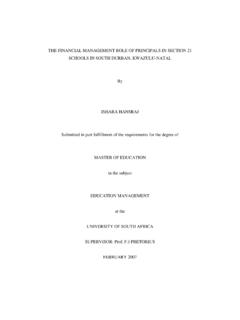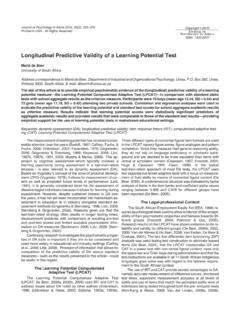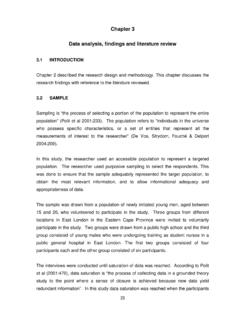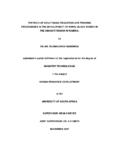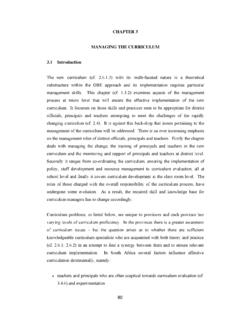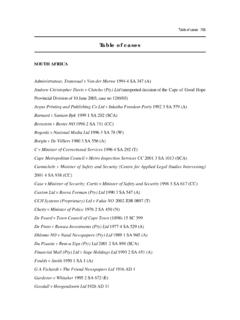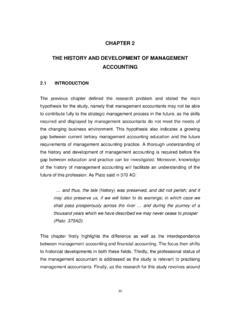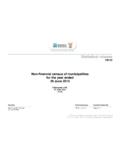Transcription of 84 CHAPTER 3 Research design, research method …
1 84 CHAPTER 3 Research design , Research method and 3 outlines the Research design , the Research method , the population under study, the samplingprocedure, and the method that was used to collect data. The reliability and validity of the researchinstrument are addressed. Ethical considerations pertaining to the Research are also DESIGNIt is the blueprint for conducting the study that maximises control over factors that could interfere with thevalidity of the findings. Designing a study helps the researcher to plan and implement the study in a waythat will help the researcher to obtain intended results, thus increasing the chances of obtaininginformation that could be associated with the real situation (Burns & Grove 2001:223). METHODA quantitative, descriptive approach was adopted to investigate reasons why women who requestedTOP services failed to use contraceptives is a quantitative study since it is concerned with the numbers and frequencies with whichcontraceptive challenges were experienced by women who requested TOP services in terms of the85 CTOP Act (no 92 of 1996) in the gert sibande district of the Mpumalannga Province of the RSA, duringAugust and September study was descriptive because it complied with the characteristics of descriptive Research asstipulated by Brink and Wood (1998: 283).
2 Descriptive designs are used for the development of a database for any science. In this study adatabase about women s reasons for failing to use contraceptives and who requested TOPs in GertSibande district has been initiated. Demographic information obtained that could aid in describing the population of women whoundergo TOPs. Descriptive studies are used when the characteristics of a population are either unknown or partiallyknown. In this study the characteristics of women who requested TOPs in the gert sibande Districtwould be correlated with those of women who underwent TOPs and participated in other and Hungler (1999:37) refer to the population as an aggregate or totality of all the objects, subjectsor members that conform to a set of specifications. In this study the population was South Africanwomen of all races, age groups, educational status, socio-economic status and residential areas, whorequested TOP services in the gert sibande district during August and September The eligibility criteriaThese criteria specify the characteristics that people in the population must possess in order to beincluded in the study (Polit & Hungler 1999:278).
3 The eligibility criteria in this study were that theparticipants had to86 be South African citizens have requested TOPs under the CTOP Act (no 92 of 1996) obtain TOP services at the Bethal Hospital in the gert sibande SAMPLING PROCEDUREThe process of selecting a portion of the population to represent the entire population is known assampling (LoBiondo-Wood & Haber 1998:250; Polit & Hungler 1999:95). A number of women whorequested TOPs under the CTOP Act (no 92 of 1996) in gert sibande district was selected. Time andmoney was saved by selecting a sample to be studied rather than attempting to study the entirepopulation of women who requested TOP services. Obtaining data from the population of women aswell as analysing and interpreting vast amounts of data would have been impossible to accomplishwithin the time constraints and with the limited financial resources which were available for conductingthis samplingA non-probability sampling method was adopted which, according to LoBiondo-Wood and Haber(1998:249), is less vigorous and tends to produce less accurate and less representative samples thanprobability or random samples.
4 Non-probability sampling implies that not every element of thepopulation has an opportunity for being included in the sample, such as convenience (accidental),quota, purposive and network sampling procedures (Burns & Grove 2001:804). The non-probabilitysampling procedure might have limited the generalisability of the sample is a subset of a population selected to participate in the study, it is a fraction of the whole,selected to participate in the Research project (Brink 1996:133; Polit & Hungler 1999:227). In thissurvey, a subset of 55 women was selected out of the entire population of women who requested TOPsin the gert sibande Convenience sampleA convenience sample comprising 55 women who requested TOPs in the gert sibande district duringAugust and September 2003 was selected. De Vos (1998:199), as well as LoBiondo-Wood and Haber(1998:253) describe a convenience sample as the use of readily accessible persons in a study.
5 Anycase, which happens to cross the researcher s path, and meets the inclusive criteria set for the study,gets included in a convenience sample. The researcher finds it easy to obtain participants, but the riskof bias is greater than in a random sample, because each member of the population does not have anequal chance of being included in the sample. Obtained results might not be generalisable to the sizeA general rule of the thumb is to always use the largest sample possible. The larger the sample themore representative it is going to be, smaller samples produce less accurate results because they arelikely to be less representative of the population (LoBiondo-Wood & Haber 1998:263-264). In thisstudy a convenience sample of 55 respondents has been obtained, from women who requested TOPservices at Bethal Hospital in the gert sibande district during August and September 2003. Womenwho requested TOP services and who were in the hospital at the times when the researcher conductedinterviews and who were willing to be interviewed were included in the sample.
6 According to theMpumalanga Department of Health (1997-2002), Bethal Hospital is the main hospital, which rendersTOP services in gert sibande Sampling rationaleAccording to Polit and Hungler (1999:225), sampling helps because it was more economical to choose a sample of 55 women who requested TOPs, instead of studyingthe entire population of women who requested TOPs in the gert sibande district . it was unnecessary to collect data from the entire population of women who requested TOPs in GertSibande district , as contraceptive challenges could be understood by securing information from thesample that was chosen. De Vos (1998:191) indicated that (convenience) sampling could be regarded as being a rationalchoice in cases where it was impossible to identify all the members of a population. In this survey itwas impossible to predict which women would request TOPs in gert sibande district during Augustand September 2003.
7 Although the population of women who underwent TOPs during these twomonths could have been determined retrospectively, drawing a random sample and tracing thewomen for interviews would have been difficult, if not impossible. It might have been impossible totrace many of the TOP clients once they had left the hospital, because they might have relocated todifferent places. Many of them might not have granted interviews once they had left the hospital astheir families and friends might have been unaware of their TOPs. As the researcher knew thatmany women obtained TOP services without confiding in any other people, the researcherregarded it to be in the interest of these women to conduct the interviews while they were in hospitalrather than to attempt to trace them subsequent to their discharge from the DATA COLLECTIONP olit and Hungler (1999:267) define data as information obtained in a course of a study.
8 In this studydata was collected by using structured interview schedules. A structured interview schedule was usedin order to capture data relevant to the study s objectives and Research questions. The purpose of the89study was to identify and describe contraceptive challenges experienced by women who requestedTOPs in the gert sibande district during August and September data collection instrumentThe literature reviewed indicated that challenges exist even before contraceptive use can be initiated,and during the use of contraceptives. The structured interview tool was formulated to capturecontraceptive challenges facing women before contraceptive use can be initiated, and those that areexperienced during the use of contraceptives. The structured interview schedule (included asannexure C of this dissertation) comprised the following sections: Section 1. Questions related to demographic information of the women who requested TOPs.
9 Section 2. Questions related to contraceptive challenges existing before contraceptive use can beinitiated. Section 3. Questions related to contraceptive challenges experienced during the use ofcontraceptives. Section 4. Questions related to the TOP procedure is defined as a measure of truth or falsity of the data obtained through using the researchinstrument. It is classified as internal and external validity of the measuring instrument (Burns & Grove2001:226). In this study validity refers to the measure of truth or falsity of the assumed contraceptivechallenges as experienced/reported by women who requested TOP services. The instrument s validitycan be regarded as the extent to which .. the instrument actually reflects the abstract construct beingexamined (Burns & Grove 2001:814). Several factors could influence the internal and external validityof the measuring instrument, the structured interview schedule used in this survey to gather data aboutreasons why women who requested TOPs, failed to use contraceptives validityThis concept indicates the extent to which the factors, identified as contraceptive challenges by womenwho requested TOP services, truly reflect what hinders effective contraceptive usage, rather than beingattributable to extraneous or chance variables, not necessarily indicating contraceptive challenges(Burns & Grove 2001:800).
10 Threats to internal validityThe occurrence of an event, which may be unrelated to the study but can affect the result of the studyposes a possible threat to the internal validity of the data (Burns & Grove 2001:228). The mostimportant threats to the internal validity of this study were factors related to the history of the participants contraceptive use and the selection processes of the women who were interviewed. Several factors inthis study have been identified as contraceptive challenges, like the lack of knowledge aboutcontraceptives, lack of education, and the side-effects experienced during contraceptive and many other factors are said to hinder effective contraceptives use. Historical threats tointernal validity could include the admission by the participants in this study that these factors werechallenges experienced by them. Historically, in the RSA contraceptives are freely available to preventunwanted pregnancies.

